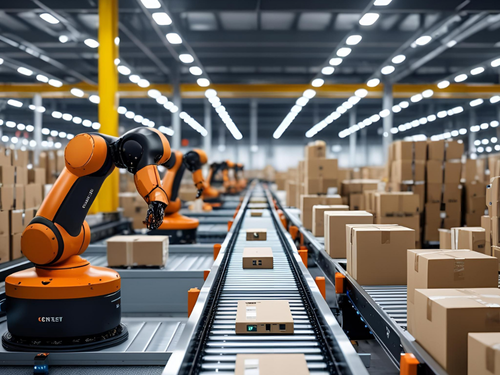The Shift to Smart Warehousing
From Static to Smart
Warehouses have evolved from basic storage spaces into dynamic data-driven facilities. This transition is largely due to the integration of digital infrastructure and real-time monitoring systems. Smart environments are now expected, not optional.
Enabling Operational Visibility
The visibility of inventory and processes inside smart warehouses drives smarter decisions. This access to live information allows staff and systems to adjust faster. Predictive restocking depends on this constant stream of accurate data.
Supporting Agile Fulfillment
Warehouses that adapt quickly are better suited to modern fulfillment demands. Predictive restocking works best when paired with agile systems that can respond to change. Flexibility is built into every layer of smart warehousing.
Why Predictive Restocking Matters
Avoiding Stockouts

Warehouses with predictive models can anticipate shortages before they occur. This proactive approach keeps shelves stocked and customers satisfied. It also reduces last-minute procurement costs.
Minimizing Overstock
Predictive restocking doesn’t just prevent running out of goods—it also avoids over-ordering. Warehouses that hold too much inventory tie up capital and space unnecessarily. Smarter models strike a better balance.
Enhancing Service Levels
Predictive restocking supports faster and more accurate order fulfillment. This consistency improves service levels and builds trust with customers. Smart warehouses contribute directly to these higher standards.
The Role of IoT in Warehouses
Sensor-Driven Accuracy
IoT sensors provide real-time tracking of stock, equipment, and movement. They reduce the risk of human error and improve inventory accuracy. These inputs strengthen predictive models.
Connected Systems
Smart warehouses use connected devices to communicate across departments. These systems share data that supports synchronized restocking and fulfillment. Integration is the backbone of efficiency.
Continuous Data Flow
IoT generates a continuous feed of actionable information. This stream keeps predictive restocking models updated with the latest stock levels and movement trends. Real-time data empowers fast decisions.
Integrating AI and Machine Learning
Learning from Patterns

AI models inside warehouses analyze recurring trends in purchasing, returns, and seasonality. This helps them refine restocking triggers over time. The more data they ingest, the smarter they become.
Automated Adjustments
Machine learning enables warehouses to auto-adjust stock levels without human input. These smart decisions align with consumption rates and upcoming demand. Manual forecasting becomes unnecessary.
Forecast Refinement
AI-driven models constantly refine predictions using new data. Warehouses become more responsive as the system matures. Over time, this reduces both shortages and excess.
Real-Time Inventory Monitoring
Instant Stock Insights
Warehouses with real-time monitoring can spot low-stock items instantly. This allows predictive models to trigger restocking faster. Speed is key in avoiding fulfillment delays.
Cloud-Based Dashboards
Smart dashboards show inventory performance at a glance. These tools help warehouse teams monitor trends and take action quickly. They’re also crucial for remote management.
Reduced Blind Spots
Real-time tools eliminate guesswork and improve inventory visibility. Every product’s location and quantity is known at all times. Predictive restocking relies on this level of precision.
Data-Driven Demand Forecasting
Merging Multiple Data Sources
Smart warehouses pull data from sales, returns, and seasonal trends. Combining this data gives a fuller picture of future demand. The more sources used, the more accurate the forecast.
Dynamic Inventory Targets
Predictive restocking adjusts stock levels based on evolving data. These targets are flexible and update as new information arrives. Static reorder points are replaced by intelligent ones.
Improved Planning Cycles
Demand forecasting smooths out supply planning. Warehouses can better align with supplier lead times and customer expectations. This creates a more stable and responsive supply chain.
Cost Optimization Through Smart Planning

Avoiding Rush Orders
Better forecasting allows warehouses to avoid emergency purchases. These last-minute orders often carry higher costs. Predictive models promote planned purchasing.
Balanced Stock Levels
Smart warehouses avoid over-ordering that leads to storage costs. Predictive restocking keeps just the right amount on hand. It reduces waste and improves margins.
Supplier Negotiation Power
With better planning, warehouses can negotiate better supplier terms. Bulk orders and long-term schedules lower costs. Predictive models enable this advantage.
Scalability for Growing Businesses
Adaptable Systems
Smart warehouses scale easily as product lines and sales channels grow. Their systems adapt to changing volume without disruption. Predictive restocking keeps pace with expansion.
Multi-Location Syncing
Predictive models work across multiple warehouses. This synchronization prevents gaps in stock availability. Businesses maintain control even as networks grow.
Reduced Complexity
Smart systems reduce complexity in managing inventory across larger operations. Predictive restocking handles thousands of SKUs automatically. This efficiency is key to growth.
Custom Restocking Thresholds Based on Behavior

SKU-Level Precision
Predictive models assign restocking thresholds to each SKU. These thresholds change based on demand patterns. This personalized approach avoids blanket rules.
Trigger-Based Alerts
Thresholds are linked to automatic alerts and restocking actions. Warehouses respond to actual data instead of fixed timelines. This improves supply accuracy.
Seasonal Adjustments
Smart thresholds account for seasonal demand. Predictive models adjust reorder points during high or low seasons. This fine-tuning keeps shelves balanced.
The Vareya Advantage in Smart Fulfillment
Tech-Enabled Fulfillment
Vareya builds fulfillment solutions powered by smart warehouse technology. Their focus is on integrating AI and automation for better restocking. Clients benefit from predictive accuracy and speed.
Data-First Execution
Vareya emphasizes the role of real-time data in warehouse decisions. Predictive restocking is part of their core approach. This enables faster, smarter operations.
Scalable Support
As clients grow, Vareya’s systems scale with them. Smart warehouses make expansion smooth and sustainable. Predictive restocking is just the beginning of what they offer.
Key Takeaways
Smart warehouses are the foundation for predictive restocking, combining IoT, AI, and automation to improve inventory accuracy and fulfillment speed. With dynamic thresholds, data-driven forecasting, and system integration, businesses reduce costs, avoid shortages, and maintain balance. Vareya helps implement these solutions for scalable, modern fulfillment operations that stay ahead of demand.

